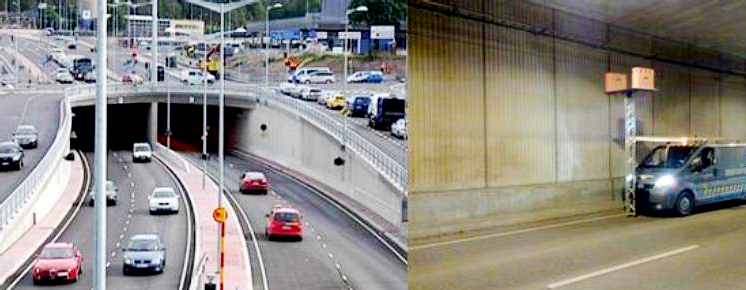
Using nondestructive testing technologies to rapidly and comprehensively pinpoint defects in or behind tunnel linings.
Nondestructive Testing for Tunnel Linings (R06G)
Challenge
Tunnel inspection is a challenging problem, but owners routinely need to test the integrity of the concrete lining of their tunnels to maintain and repair their assets. Tunnels typically service high-volume traffic and operate in aggressive environments. As a result, they are difficult to inspect for maintenance concerns or deficiencies such as leaks, concrete liner cracking, concrete spalling, delamination, and other debonding issues. Due to their confinement, heavy use, and the often long detours needed when they are closed to traffic, tunnels pose a unique operational challenge that technology is poised to solve.
Solution
Nondestructive testing (NDT) methods are automated, quantitative, and rapid; they provide substantially more complete coverage than conventional visual inspections. SHRP2 has evaluated all the best NDT technologies for their use in tunnel lining assessments. Ground-penetrating radar (GPR), infrared thermography analysis, and impact echo technology were determined to be the most appropriate. These technologies enable inspectors to drive through the tunnel and conduct the inspection without closing lanes.
The web-based, open-source NDToolbox helps identify and characterize testing technologies that are available to locate the primary deficiencies in tunnel linings. With the toolbox, users can explore different NDT technologies and examine their use in detecting deterioration for conditions relevant to the project. The NDToolbox describes the technology and the physical principle behind it, applications, performance, limitations, equipment, test procedures and protocols, and sample results. It also provides recommendations regarding the best technologies for a particular deterioration detection application.
The accompanying user’s manual was developed for selecting NDT technologies that can detect defects behind or within tunnel linings. The manual includes more in-depth information on equipment, test procedures, inspector’s training requirements, data management procedures, data analysis procedures, limitations, and interpretation guidelines.
Benefits
Using these NDT methods can minimize tunnel shutdowns, resulting in fewer detours. NDT tunnel method procedures provide safety during the testing process and capture 100 percent coverage of the tunnel walls.
-

Save Lives
Detecting tunnel deficiencies early increases safety for the traveling public.
-

Save Money
Improving inspections means managing tunnels more effectively. Using rapid NDT techniques minimizes traffic impacts, costly tunnel shutdowns, and detours.
-

Save Time
Avoiding prolonged tunnel shutdowns during inspections saves time.


